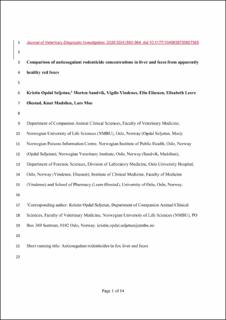| dc.contributor.author | Seljetun, Kristin Opdal | |
| dc.contributor.author | Sandvik, Morten | |
| dc.contributor.author | Vindenes, Vigdis | |
| dc.contributor.author | Eliassen, Elin | |
| dc.contributor.author | Øiestad, Elisabeth Leere | |
| dc.contributor.author | Madslien, Knut Ivar Engesæter | |
| dc.contributor.author | Moe, Lars | |
| dc.date.accessioned | 2020-11-30T10:09:02Z | |
| dc.date.available | 2020-11-30T10:09:02Z | |
| dc.date.created | 2020-09-04T10:50:35Z | |
| dc.date.issued | 2020 | |
| dc.identifier.citation | Journal of Veterinary Diagnostic Investigation. 2020, 32(4), 560-564. | en_US |
| dc.identifier.issn | 1040-6387 | |
| dc.identifier.uri | https://hdl.handle.net/11250/2690134 | |
| dc.description.abstract | Exposure of wildlife and domestic animals to anticoagulant rodenticides (ARs) is a worldwide concern, but few methods exist to determine residue levels in live animals. Traditional liver detection methods preclude determining exposure in live wildlife. To determine the value of assessing AR exposure by fecal analysis, we compared fecal and liver residues of ARs in the same animals. We collected liver and fecal samples from 40 apparently healthy red foxes (Vulpes vulpes) potentially exposed to ARs, and quantified brodifacoum, bromadiolone, coumatetralyl, difenacoum, difethialone, and flocoumafen residues by liquid chromatography–tandem mass spectrometry. Residues of ARs were detected in 53% of the fecal samples and 83% of the liver samples. We found good concordance between AR residues in feces and liver for coumatetralyl, difenacoum, and difethialone. Bromadiolone occurred in significantly greater frequency in livers compared to feces, but no significant difference in concentration between feces and liver in individual foxes could be detected. Brodifacoum displayed a significant difference in concentration and occurrence of positive samples between liver and feces. Our findings demonstrate that fecal analysis of ARs provides a feasible and valuable non-lethal means of determine AR exposure in live wildlife. | en_US |
| dc.language.iso | eng | en_US |
| dc.rights | Attribution-NonCommercial-NoDerivatives 4.0 Internasjonal | * |
| dc.rights.uri | http://creativecommons.org/licenses/by-nc-nd/4.0/deed.no | * |
| dc.title | Comparison of anticoagulant rodenticide concentrations in liver and feces from apparently healthy red foxes | en_US |
| dc.type | Peer reviewed | en_US |
| dc.type | Journal article | en_US |
| dc.description.version | acceptedVersion | en_US |
| dc.source.pagenumber | 560-564 | en_US |
| dc.source.volume | 32 | en_US |
| dc.source.journal | Journal of Veterinary Diagnostic Investigation | en_US |
| dc.source.issue | 4 | en_US |
| dc.identifier.doi | 10.1177/1040638720927365 | |
| dc.identifier.cristin | 1827317 | |
| cristin.ispublished | true | |
| cristin.fulltext | postprint | |
| cristin.qualitycode | 1 | |

